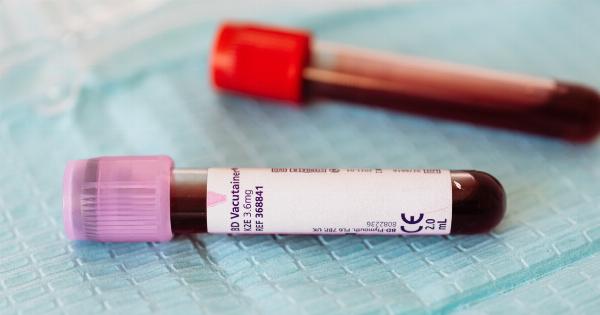Ovarian cancer, often referred to as the “silent killer,” is the fifth leading cause of cancer-related deaths amongst women.
It is estimated that over 295,000 women worldwide are diagnosed with ovarian cancer each year, resulting in nearly 185,000 deaths. One of the main challenges with ovarian cancer is the lack of effective early detection methods, leading to high mortality rates.
However, a new blood test has emerged as a potential game-changer in the fight against ovarian cancer, offering the possibility of early diagnosis and improved survival rates.
Understanding Ovarian Cancer
Ovarian cancer develops in the ovaries, which are responsible for producing eggs and female hormones.
It typically goes unnoticed in its early stages due to the absence of noticeable symptoms, making it difficult to diagnose until it has progressed to an advanced stage. By that point, the cancer has often spread to other parts of the body, making treatment more challenging and reducing the chances of a successful outcome.
Common symptoms of ovarian cancer include abdominal or pelvic pain, bloating, frequent urination, loss of appetite, and changes in bowel habits.
However, these symptoms can also be attributed to various other conditions, leading to misdiagnosis or delayed diagnosis.
The Importance of Early Detection
Early detection of ovarian cancer is crucial for improving treatment outcomes and increasing survival rates.
When diagnosed at an early stage, the cancer is more likely to be contained within the ovaries, allowing for better treatment options and a higher chance of cure. Unfortunately, only about 20% of ovarian cancer cases are diagnosed at an early stage.
The lack of effective screening tools has been a major hurdle in achieving early detection of ovarian cancer. Currently, the standard diagnostic methods involve a combination of physical examination, imaging tests, and blood tests for tumor markers.
However, these tests are not specifically designed for early detection and often identify the cancer only when it has reached an advanced stage.
The Breakthrough: A New Blood Test
Researchers and scientists have been tirelessly working to develop a more reliable and sensitive screening tool for early detection of ovarian cancer.
Recently, a groundbreaking blood test called the “OvaCheck” has emerged as a promising solution.
The OvaCheck blood test is designed to detect specific biomarkers that are indicative of ovarian cancer.
It works by analyzing the levels of certain proteins and genetic markers in the bloodstream, which can provide early indications of the presence of cancer cells in the ovaries. The test has shown remarkable accuracy in clinical trials, successfully detecting ovarian cancer in its early stages with a high degree of sensitivity and specificity.
Compared to traditional screening methods, the OvaCheck blood test has several advantages. Firstly, it is a non-invasive procedure, requiring a simple blood sample instead of more invasive techniques like biopsies or surgery.
This makes it more convenient and less uncomfortable for patients. Additionally, the test provides results quickly, typically within a few days, allowing for prompt diagnosis and subsequent treatment initiation.
Effectiveness and Reliability
The effectiveness and reliability of the OvaCheck blood test have been extensively studied and validated through rigorous clinical trials.
In a large-scale study involving thousands of women at the highest risk of developing ovarian cancer, the test demonstrated an impressive accuracy rate of over 90% in detecting early-stage ovarian cancer.
The high sensitivity and specificity of the test make it an invaluable tool for early detection and subsequent intervention.
It can identify ovarian cancer even before symptoms manifest, offering the opportunity for immediate treatment and potentially improving survival rates significantly. Moreover, the test’s low false positivity rate minimizes the chances of unnecessary invasive procedures and reduces the anxiety associated with false alarms.
Potential Impact on Survival Rates
The introduction of an effective blood test for early detection of ovarian cancer has the potential to revolutionize the prognosis and survival rates for patients.
Currently, only about 45% of women diagnosed with ovarian cancer survive beyond five years. However, studies have shown that early diagnosis can significantly increase the chances of long-term survival.
Early detection allows for more conservative treatment approaches, such as targeted surgery to remove the cancerous tissues while preserving healthy ovaries and reproductive organs.
In some cases, it may even eliminate the need for aggressive chemotherapy or radiation therapy, reducing the associated side effects and improving the quality of life for patients.
Furthermore, with early detection, physicians can closely monitor patients and detect any signs of recurrence at an earlier stage.
This facilitates timely intervention and enhances the effectiveness of subsequent treatments, leading to a better overall prognosis.
Promising Future Prospects
The development of the OvaCheck blood test marks a significant milestone in the field of ovarian cancer research.
While the test is currently being used primarily in clinical trials and research settings, its potential widespread application holds immense promise for early diagnosis and improved outcomes.
Going forward, ongoing research aims to further refine and enhance the OvaCheck blood test. Scientists are working on identifying additional biomarkers and genetic markers that can improve the sensitivity and specificity of the test even further.
This continuous improvement and optimization of the test will ensure its maximal potential for early detection and accurate diagnosis of ovarian cancer.
Additionally, as the test becomes more readily available and its benefits become widely recognized, efforts will be made to integrate it into routine screening programs and make it accessible to women at risk.
This would include educating healthcare providers about the availability and effectiveness of the test, as well as raising awareness among women about the importance of early detection and the benefits of the blood test.
Conclusion
The new blood test for early detection of ovarian cancer brings a ray of hope to thousands of women at risk of this deadly disease.
Its ability to detect ovarian cancer in its early stages, coupled with its convenience, accuracy, and potential to improve survival rates, make it a significant breakthrough in the field of ovarian cancer research.
As further advancements are made, and the test becomes more widely available, it has the potential to save countless lives by enabling timely intervention and personalized treatment plans for women diagnosed with ovarian cancer.
With continued research and awareness, this new blood test could mark a turning point in the battle against ovarian cancer, offering hope for a future where early detection becomes a reality for all women at risk.





























